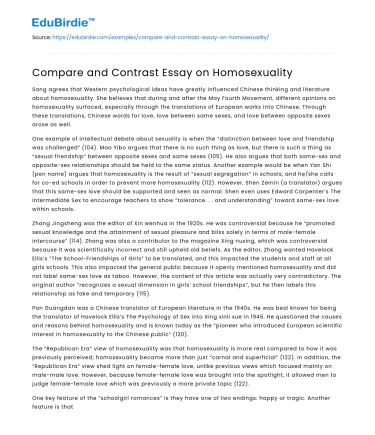Sang agrees that Western psychological ideas have greatly influenced Chinese thinking and literature about homosexuality. She believes that during and after the May Fourth Movement, different opinions on homosexuality surfaced, especially through the translations of European works into Chinese. Through these translations, Chinese words for love, love between same sexes, and love between opposite sexes arose as well.
One example of intellectual debate about sexuality is when the “distinction between love and friendship was challenged” (104). Mao Yibo argues that there is no such thing as love, but there is such a thing as “sexual friendship” between opposite sexes and same sexes (105). He also argues that both same-sex and opposite-sex relationships should be held to the same status. Another example would be when Yan Shi (pen name) argues that homosexuality is the result of “sexual segregation” in schools, and he/she calls for co-ed schools in order to prevent more homosexuality (112). However, Shen Zemin (a translator) argues that this same-sex love should be supported and seen as normal. Shen even uses Edward Carpenter’s The Intermediate Sex to encourage teachers to show “tolerance. . . and understanding” toward same-sex love within schools.
Save your time!
We can take care of your essay
- Proper editing and formatting
- Free revision, title page, and bibliography
- Flexible prices and money-back guarantee
Zhang Jingsheng was the editor of Xin wenhua in the 1920s. He was controversial because he “promoted sexual knowledge and the attainment of sexual pleasure and bliss solely in terms of male-female intercourse” (114). Zhang was also a contributor to the magazine Xing nuxing, which was controversial because it was scientifically incorrect and still upheld old beliefs. As the editor, Zhang wanted Havelock Ellis’s “The School-Friendships of Girls” to be translated, and this impacted the students and staff at all girls schools. This also impacted the general public because it openly mentioned homosexuality and did not label same-sex love as taboo. However, the content of this article was actually very contradictory. The original author “recognizes a sexual dimension in girls’ school friendships”, but he then labels this relationship as fake and temporary (115).
Pan Guangdan was a Chinese translator of European literature in the 1940s. He was best known for being the translator of Havelock Ellis’s The Psychology of Sex into Xing xinli xue in 1946. He questioned the causes and reasons behind homosexuality and is known today as the “pioneer who introduced European scientific interest in homosexuality to the Chinese public” (120).
The “Republican Era” view of homosexuality was that homosexuality is more real compared to how it was previously perceived; homosexuality became more than just “carnal and superficial” (122). In addition, the “Republican Era” view shed light on female-female love, unlike previous views which focused mainly on male-male love. However, because female-female love was brought into the spotlight, it allowed men to judge female-female love which was previously a more private topic (122).
One key feature of the “schoolgirl romances” is they have one of two endings: happy or tragic. Another feature is that there is usually a male or female main character who has “inborn talents and emotional hypersensitivity” (37). This main character meets his/her lover and is attracted through “passion” and “bodily desire” (37). If it is a tragedy, the lovers are usually kept apart for some reason, and their story commonly ends with death or separation. However, some school girl romances also include the perspective of the other lover and have no closure (41).
I would say that schoolgirl romances are more progressive in general because they bring to attention female-female love, which was something to be ashamed of in the past. As Marin mentions, these schoolgirl romances push for females to have choices when it comes to marriage. For example, these romances promote “women’s freer choice in marriage” and discourageWhen Martin mentions the “schoolgirl lover” and “lifelong tomboy” (48), she means that these two descriptions are two different ways people portray and perceive female-female lovers. Whenever homosexual females are portrayed in Chinese popular culture, they are portrayed as one of two “constructions” (48). Specifically, “the universalizing model of the temporary schoolgirl lover” means the type of homosexual female that people are starting to get accustomed to and assume all female-female relationships are schoolgirl romances (48). On the other hand, “the minoritizing understanding of the lifelong tomboy” means the less feminine, more “mannish” type of homosexual female (48). female “exclusion from education” (37). In addition, as Martin mentions, having schoolgirl romances portrayed in popular media has “markedly different aesthetic and ideological effects” (44). Having these schoolgirl romances as the main topic or plot in story gives the public a different perspective of same-sex love; it makes their relationships more real.






 Stuck on your essay?
Stuck on your essay?

